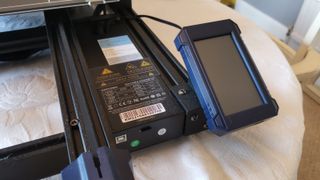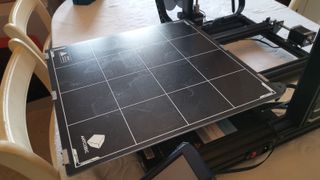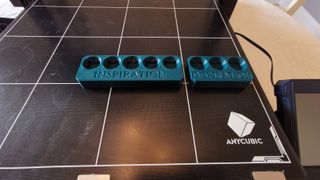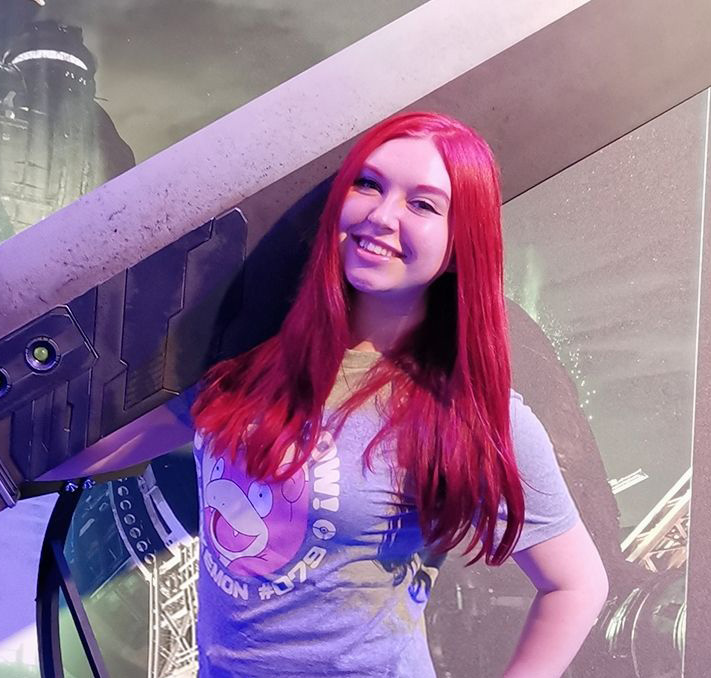TechRadar Verdict
The Anycubic Kobra Max is a pricey investment for hobbyists and enthusiasts, but it's far from being overpriced. Offering up convenience in the form of a massive build plate, the Kobra Max is perfect for cosplayers, prop makers and small businesses looking to maximize their production output.
Pros
- +
Huge print area
- +
Auto-leveling is convenient
- +
Printing results are high quality
Cons
- -
No larger nozzle included
- -
Printing is slow going
- -
No removable print bed
Why you can trust TechRadar
Anycubic Kobra Max: two minute review
The Anycubic Kobra Max is likely going to be the printer that folks will have on their wishlist if they're into cosplay, prop production, or simply looking to maximize their production output. Images alone can't make you fully appreciate just how large this FDM-style printer is, rocking a build volume capacity of 17.7 x 15.7 x 15.7 inches / 450 x 400 x 400 mm.
Large-scale FDM (Fused Deposition Modeling) is hardly a new or unique concept, but options are much more limited if you want something bigger than a traditional-sized printer, and with printing technology evolving at such a rapid pace, there are features present on the Anycubic Kobra Max that were either too expensive to include on older hardware, or simply didn't exist for consumer machines a few years ago.
What the Kobra Max offers at its core though, is convenience. Depending on what you're looking to print, the smaller build plate on traditionally sized FDM printers might be too restrictive for batch printing, or you might not like having to split large models into smaller sections which will require some technical skills if the file doesn't come pre-sliced.
With this, you're sacrificing your own space as a larger printer will dominate most of your workbench, but for some, that's a small price to pay for a machine that can print a full-sized cosplay helmet in one piece.
Anycubic Kobra Max: price and availability
- How much is it? You can buy it for $570 / £540 / AU$860
- When can you get it? It is available now
- Where is it available? It's available almost worldwide (check Anycubic website for full availability)

The Anycubic Kobra Max is available in the US, UK, and Australia, as well as other regions globally, and you can purchase it either directly on the Anycubic website or via third-party retailers such as Amazon.
It'll cost you around $570 / £540 / AU$860, though sales are frequent so you can likely snap one up for less if you keep your eye on listings. That said, this feels well priced for the Anycubic Kobra Max given its size and features will have a more niche appeal to consumers.
For comparison's sake, the Creality Ender 5 Plus is a popular large-scale FDM printer that has a smaller print capacity (350 x 350 x 400mm) and that costs a smidge more at $579, though smaller machines will save you a good heap of cash if you have a tight budget. The Anycubic Vyper is a smaller alternative from the same brand that offers a build volume of 245mm × 245 × 260mm and costs $359 (around £255 / €300 / AU$460).
Anycubic Kobra Max: design
- Great build quality, ideal for professional workshop or studio environments
- Large size could be difficult to set up in a typical home
Assembling the Anycubic Kobra Max is a straightforward process if you have previous experience using printers, and for those who don't, the instructions are well written with clear illustrations provided. It should only take around 20-30 minutes to get it up and running, though we would advise that you don't try and put it together alone given its sheer size.
It's also worth mentioning that because the bed moves backward and forward, there needs to be space behind the printer so you can't have it sat flush against the wall. This means you might struggle to fit the fully assembled printer onto surfaces in your home, such as a cabinet or desk, but a standard-sized kitchen worktop had no issues, so most workshop workbenches or dining tables should also be fine.
Printing Technology: FDM
Supported filaments: PLA, TPU, ABS, PETG
Build Volume: 17.7 x 15.7 x 15.7 inches / 450 x 400 x 400 mm
Print resolution: 0.05mm - 0.3mm
Positioning accuracy: X/Y 0.0125mm; Z 0.002mm
Extruder number: Single; Nozzle diameter: 0.4 mm
Print Speed: 20 - 100 mm/s (recommended 80 mm/s)
Ambient Operating Temperature: 8°C - 40°C
Operational Nozzle Temperature: 500 °F / 260 °C
Operational Hot Bed Temperature: 194 °F / 90 °C
Connection mode: SD Card; USB cable
Machine size: 28.3 x 28.1 x 26.2 inches / 720 x 715 x 665 mm
Weight: Machine weight: ~16kg
The Anycubic auto-leveling system is dubbed 'LeviQ' and works well, sparing those without any experience in printing from having to manually level the print bed. That said, it isn't perfect and we did experience an immediate failure because of print bed adhesion during our first test.
It's a feature we would suggest that you prioritize in printers though, as manual leveling can be a real pain, and a time-consuming one at that. Even seasoned professionals and experienced hobbyists can appreciate being able to get a machine ready to print with just a few button clicks.
As far as build quality goes, the Kobra Max was well constructed (humblebrag) and we couldn't see any of the messy wires or tape that made its smaller cousin, the Anycubic Vyper, look so unkempt. There's a lot of plastic on show, buts it's solid and clean, so the machine won't look out of place in a professional workshop or studio.
Anycubic Kobra Max: features
- Lack of larger nozzle is a disappointment
- Glass surface is easy to clean and remove smaller finished prints




Unlike other Anycubic printers, the build plate on the Kobra Max is made from borosilicate glass covered in Anycubic's proprietary Ultrabase texture which becomes 'sticky' when warm, and then separates from the print itself when cool.
We do have mixed feelings about the glass build plate unfortunately. The concept is innovative (though not exclusive to Anycubic) and it's fascinating to see that finished prints will remove themselves after the glass cools down, but this being a large-scale machine actually means we were disappointed that the print bed is not removable like the PEI Flexplate system from the Vyper and the standard Kobra.
The textured glass surface works well to keep the build plate clean, unlike metal surfaces that can be quick to collect stubborn filament residue, but removing large prints was a bigger hassle. We didn't have to use too much brute force but there's always the risk that you can damage a print by trying to remove it too forcefully, which is less than ideal if said print is a huge, detailed model that may have taken several days to complete.

A downside to the Kobra Max is its sheer weight, so while you can increase the print speeds in your slicer, pushing it too far could ghosting or ringing of fine details in your print due to the acceleration. It also makes it difficult to move around if you can't keep it in a fixed location, so this is a printer you'll want to keep in one place.
The LCD control panel located on the right-hand side of the printer is very responsive and easy to use, with clear instructions on-screen even if you don't want to read through the paper manual. It does tend to make some sharp beeping noises when a print is completed, but you can adjust this directly on the control center.
Another criticism is with the nozzle. The 0.4mm Volcano hotend is great, but its size is restrictive and becomes a bottleneck when you put it on a printer of this scale, especially if you want to mostly print large models. It would have been nice to see a 0.6mm nozzle included in the box, especially as Anycubic doesn't shy away from free accessories.
Using a larger nozzle has a few downsides, but it has a 50% wider line width which would improve rigidity and print speed, and at a large enough size most models wouldn't see a loss in detail.
Anycubic Kobra Max: performance
- Default settings cause a lot of stringing
- Fantastic detail, great quality prints with minimal effort


Print quality on the Kobra Max needs to be tweaked from its default settings, but you can get some great quality models from them if you're willing to do a lot of cleanup. It's known within the making space that 3D printing is a skill, and like any skills you need to make adjustments and put in some practice to see high-quality results, but even without playing around with the slicing settings, the models we tested were of satisfactory quality or higher.
Print speed on the Kobra Max is a slog, but that's a given because of its weight. It's also worth mentioning for those with less experience that scaling models up to a larger size could mean that the machine takes several days to complete a print, especially if you're printing something with a lot of detail, but the peak power draw of 500w running for that duration is a cost that should be factored in.

We tried a selection of different test models and found that stringing was a persistent issue, especially at the default settings provided with the Slicer profile. This is easy to clean up, and it's possible to reduce them with some adjustments, but it was a more prominent problem than we encountered using other FDM printers.
Cosplayers and prop artists will likely adore this machine though. Yes, you need to play around to optimize the results, but that's a given with every consumer-grade 3D printer on the market, and the ability to print an adult-sized cosplay helmet or armor pieces like pauldrons really is incredible to see, and saves time on painstakingly matching up and gluing together a sliced-up model on a smaller machine.


Detail was middling, but most of the criticism we have was based on models printed with default settings, and we found that issues like filament warping (as seen on the teeth of the dragon skull dice tower above) can be improved by slowing down the speed of your machine and tweaking your extruder temperature.
In short, the Anycubic Kobra Max is as good as you make it, and its build capacity offers is a worthy trade-off for the work you'll have to put into improving your own skills to operate it effectively. It's also arguably easier to learn how to make adjustments in slicing software than it is to learn how to split models into sections to print separately.
Should I buy a Anycubic Kobra Max?
Buy it if...
You want to make your own cosplays
The Anycubic Kobra Max can print large models with no issues, so you can finally create that full-sized Stormtrooper cosplay or create adult-sized accessories and props without splitting models on smaller printers.
You want to print in large batches
The print bed capacity on the Kobra Max isn't just great for large models, its also ideal for folks who want to print a lot of smaller stuff in bulk, which makes it well suited for small businesses who built their business around batch printing products.
You want something easy to operate
It does need some tweaking to perfect, but if you're happy to do some cleanup on your finished model then the Kobra Max is basically idiotproof. You can go from a sealed box to an operational printer in 20 minutes, and the operating instructions are easy to understand.
Don't buy if...
You don't need large models or batches
This isn't the most expensive printer on the market, but it would still be wasted on you if you don't make use of its available print capacity.
You need extremely high detail
FDM printers have improved in recent years, but if you want to massively reduce print lines and improve fine detail you'll need to look at getting a resin printer instead
- First reviewed May 2022
Jess is a former TechRadar Computing writer, where she covered all aspects of Mac and PC hardware, including PC gaming and peripherals. She has been interviewed as an industry expert for the BBC, and while her educational background was in prosthetics and model-making, her true love is in tech and she has built numerous desktop computers over the last 10 years for gaming and content creation. Jess is now a journalist at The Verge.

The Olympic Games Paris 2024 will feature more AI power than ever — with Intel helping lead the way

'A whole new generation of displays': researchers develop RGB LED out of miracle material perovskite, paving the way for self sensing, solar powered displays — but its hour-long service life needs to be improved first

